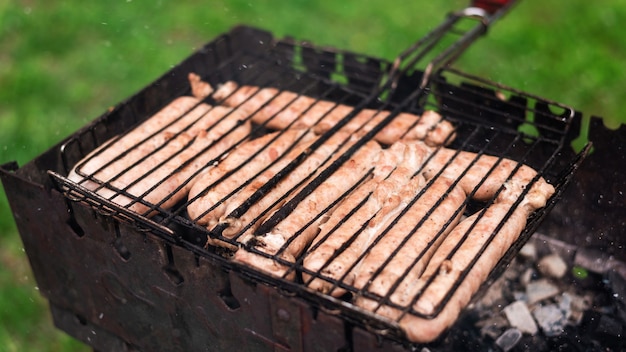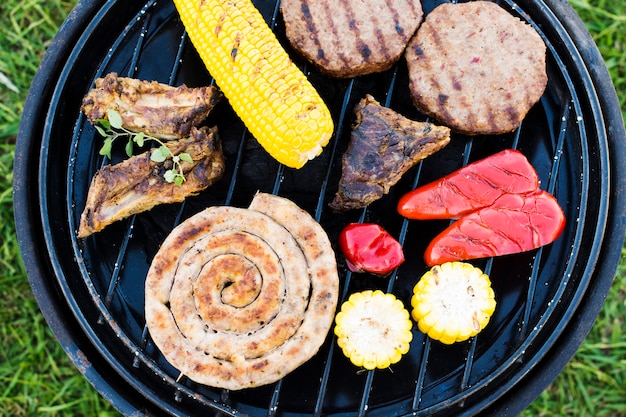Do you leave the casing on sausage when you cook it?
Introduction
If you enjoy cooking or eating sausages, you might have wondered whether you should remove the casings before cooking them. The casing is the thin layer that encases the ground meat mixture inside a sausage. While some people prefer to remove it, others choose to leave it on. In this article, we will explore the reasoning behind both options and provide you with guidance on how to cook sausages to perfection, taking into account personal preferences and culinary practices.
Leaving the Casing On
Leaving the casing on the sausage has its reasons and benefits. For starters, it helps to retain the shape of the sausage during the cooking process. The casing acts as a protective barrier, preventing the sausage from losing its form and juiciness. Additionally, leaving the casing intact can add a satisfying snap and texture to each bite, enhancing the overall eating experience.
When cooking sausages with the casing on, it is important to note that not all casings are edible. Natural casings, usually made from animal intestines, are traditional and commonly used in the UK. These casings may require removal before consuming. However, artificial casings, such as those made from cellulose or collagen, are often edible and can be enjoyed as part of the sausage.
Removing the Casing
Though some people prefer to leave the casing on, many opt to remove it before cooking. There are a few reasons for this choice. Firstly, removing the casing allows for more direct flavor infusion into the meat. By eliminating the barrier, the seasoning or marinade can penetrate the meat more effectively, resulting in a more flavorful sausage. Additionally, removing the casing provides a smoother texture, which some individuals find more enjoyable.
To remove the casing from sausages, you can either slice it lengthwise and peel it off or simply squeeze the meat out of the casing. It may require a bit of finesse, but with practice, you can become proficient at removing the casing effortlessly.
Tips for Cooking Sausages
Regardless of whether you choose to leave the casing on or remove it, cooking sausages to perfection requires some attention to detail. Here are a few tips to help you achieve delicious results:
- Preheat your cooking surface: Whether you’re grilling, frying, or baking, ensure that your cooking surface is preheated before adding the sausages. This helps to sear the exterior and seal in the juices.
- Use moderate heat: Cooking sausages over medium heat allows for even browning without burning the casing or drying out the meat.
- Monitor internal temperature: To ensure sausages are cooked thoroughly, use a meat thermometer to check their internal temperature. The recommended safe internal temperature for pork and poultry sausages is 160°F (71°C).
- Rest before serving: After cooking, let the sausages rest for a few minutes before serving. This allows the juices to redistribute and enhances the tenderness of the meat.
Should You Remove Chorizo Casing?
Chorizo is a popular cured Spanish sausage that adds depth and flavor to many dishes. However, when it comes to cooking with chorizo, one question often arises – should you remove the casing before cooking?
The Case for Removing the Casing
Some chefs and home cooks prefer to remove the casing of chorizo before cooking for several reasons:
- Texture: The casing can be tough and chewy, and removing it can result in a more tender and pleasant texture in your dish.
- Flavor Distribution: Removing the casing allows the flavorful oils and spices of the chorizo to infuse better into your dish.
- Reduced Fat Content: The casing of chorizo is often made from animal intestines, which can contain a higher fat content. Removing the casing can help reduce the overall fat content of your dish.
“Removing the casing can result in a more tender and flavorful dish.”
The Case for Keeping the Casing
On the other hand, there are chefs and cooks who argue that keeping the casing can have its benefits:
- Protects the Sausage: The casing helps keep the structure of the sausage intact while cooking, preventing it from crumbling or losing its shape.
- Enhanced Presentation: The casing can add an appealing aesthetic to your dish, especially if you are serving sliced or whole chorizo.
“Keeping the casing preserves the integrity and presentation of the chorizo.”
In the end, whether you remove the casing or not depends on personal preference and the specific requirements of your recipe. If you prefer a softer texture and want the flavors to infuse better into your dish, removing the casing is a good option. On the other hand, if you value the presentation and want the chorizo to retain its shape, keeping the casing may be more suitable.
What is the plastic coating on sausage?
Have you ever wondered about that thin plastic coating on sausages? It’s called a cellulose casing, and it serves an important purpose in sausage production.
Cellulose Casing: An Overview
The cellulose casing used for sausages is made from plant fibers, usually derived from wood or cotton. It is a popular choice among manufacturers due to its versatility and environmental benefits. Cellulose casings are biodegradable, making them an eco-friendly option compared to their synthetic counterparts.
Cellulose casings are easy to peel off, which is why they are commonly used for sausages that are cooked or heated before consumption. When cooking, the casing tightens around the sausage, helping it maintain its shape. After cooking, the casing can be easily removed or consumed, depending on personal preference.
Advantages of Cellulose Casings
Cellulose casings offer several advantages in sausage production:
- Uniformity: Cellulose casings provide a consistent diameter, resulting in sausages with uniform size and shape.
- Permeability: These casings allow for moisture and smoke penetration during cooking, enhancing the flavor and texture of the sausage.
- Cost-Effective: Cellulose casings are a cost-effective option for manufacturers, as they are less expensive than natural casings.
The Process of Applying Cellulose Casings
“The cellulose casing is applied to the sausages using a special machine. The machine fills the casing with the sausage mixture and twists it into individual links. The sausages are then ready for further processing or packaging.”
Once filled with the sausage mixture, cellulose casings are strong enough to hold the shape during cooking but can be easily removed. As a result, they provide an excellent alternative to natural casings for consumers who prefer a convenient dining experience when enjoying sausages.
In conclusion, the plastic coating on sausages is actually a cellulose casing made from plant fibers. It offers numerous advantages in sausage production, including uniformity, permeability, and cost-effectiveness. The ease of peeling off the casing makes it a popular choice among both manufacturers and consumers.
Do you take skin off sausage before cooking?
When it comes to cooking sausages, there is often a debate about whether or not to remove the skin before cooking. Some people prefer to keep the skin intact, believing that it adds flavor and texture to the dish. However, others find the skin unpalatable and choose to remove it before cooking. So, should you take the skin off sausage before cooking? Let’s explore the pros and cons.
The Case for Keeping the Skin:
Those in favor of keeping the skin argue that it helps to retain moisture and flavor during cooking. The skin also provides a satisfying snap when bitten into, adding another layer of texture to the dish. Additionally, leaving the skin on can prevent the sausages from drying out, especially when grilling or roasting them.
The Case for Removing the Skin:
On the other hand, many people prefer to remove the skin before cooking for various reasons. Some find the texture of the skin unappealing, especially if it becomes chewy or tough after cooking. Others believe that removing the skin allows for better seasoning penetration, resulting in a more flavorful sausage. Additionally, removing the skin can reduce the fat content of the dish, making it a healthier option.
“Whether or not to remove the skin ultimately comes down to personal preference.”
If you decide to remove the skin, here’s a simple guide on how to do it:
- Using a sharp knife, make a shallow slit lengthways along the sausage.
- Peel back the skin gently, ensuring not to tear it or remove too much meat.
- Continue removing the skin along the entire length of the sausage.
However, it’s worth noting that some sausages, such as Cumberland or Lincolnshire, have a coarser texture and are traditionally cooked with the skin on.
Ultimately, whether you choose to remove the skin or keep it on is a matter of personal preference. Experiment with both methods to find what works best for you and enjoy your sausages!
Should you remove the casing from sausage before cooking?
When it comes to cooking sausages, one common question that arises is whether or not to remove the casing before cooking. The decision ultimately comes down to personal preference and the type of sausage you are using. While some sausages have edible casings that add flavor and texture to the dish, others may have inedible or tough casings that are best removed.
Inedible Casings:
If you are using sausages with inedible casings, it is generally recommended to remove them before cooking. Inedible casings are usually made of materials like plastic or cellulose, which are not meant to be consumed. These casings can be tough and chewy, detracting from the overall enjoyment of the sausage.
Edible Casings:
On the other hand, if you are using sausages with edible casings, it is entirely up to your preference whether to remove them or not. Edible casings, which are typically made from animal intestines or collagen, can add a unique texture and taste to the sausage. They can become crispy when cooked, offering an enjoyable snap that many people appreciate.
However, some individuals may find the texture or taste of the casing undesirable. If this is the case, it is perfectly acceptable to remove the casing before cooking. This is particularly common when preparing sausages for children who might prefer a smoother texture.
How to Remove Sausage Casings:
If you decide to remove the casing, here’s a simple method you can follow:
- Use a small, sharp knife to make a shallow slit along the length of the sausage.
- Peel back the casing gently, being careful not to tear the meat inside.
- Continue peeling until the entire casing is removed.
Final Thoughts:
Ultimately, the decision to remove the casing from sausages before cooking is a matter of personal preference. Whether you enjoy the added texture and flavor of edible casings or prefer a smoother bite, the choice is up to you. Just remember to consider the type of sausages you are using and the preferences of those you are cooking for. Happy cooking!



